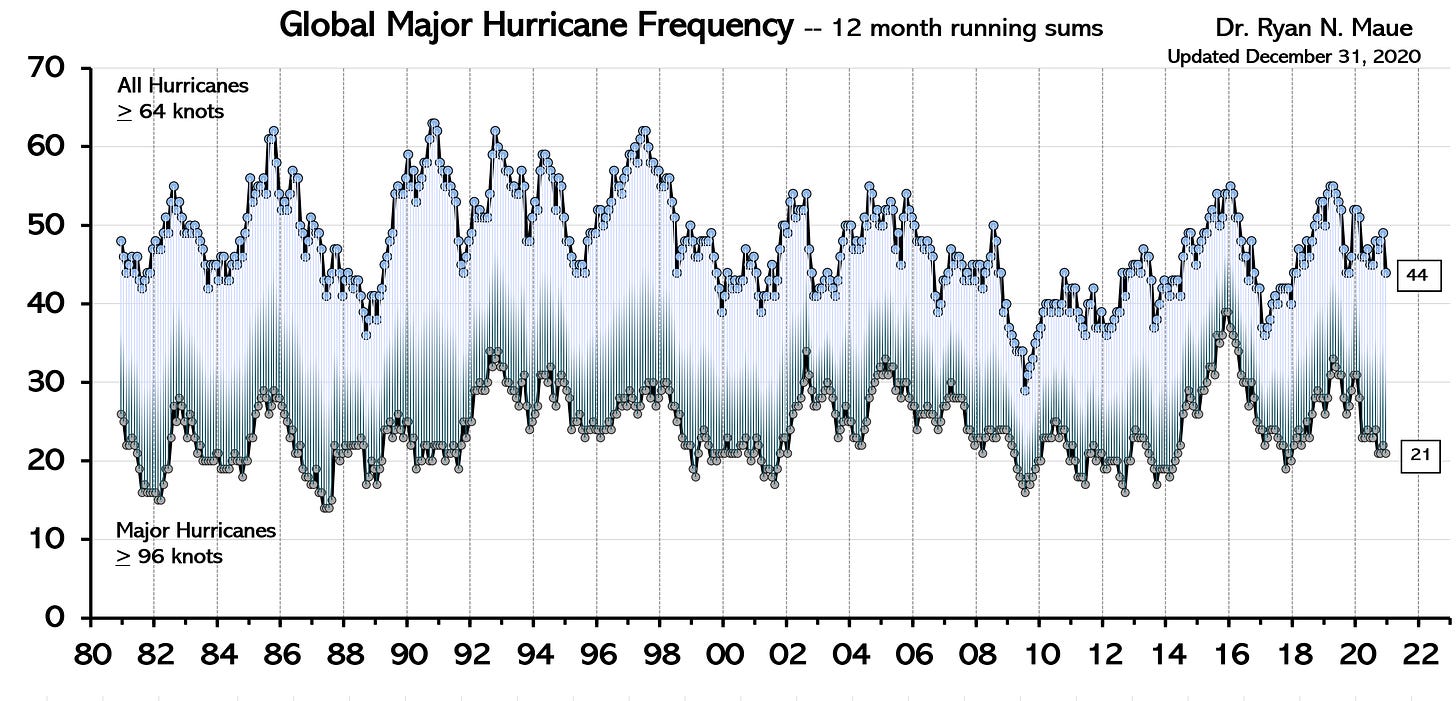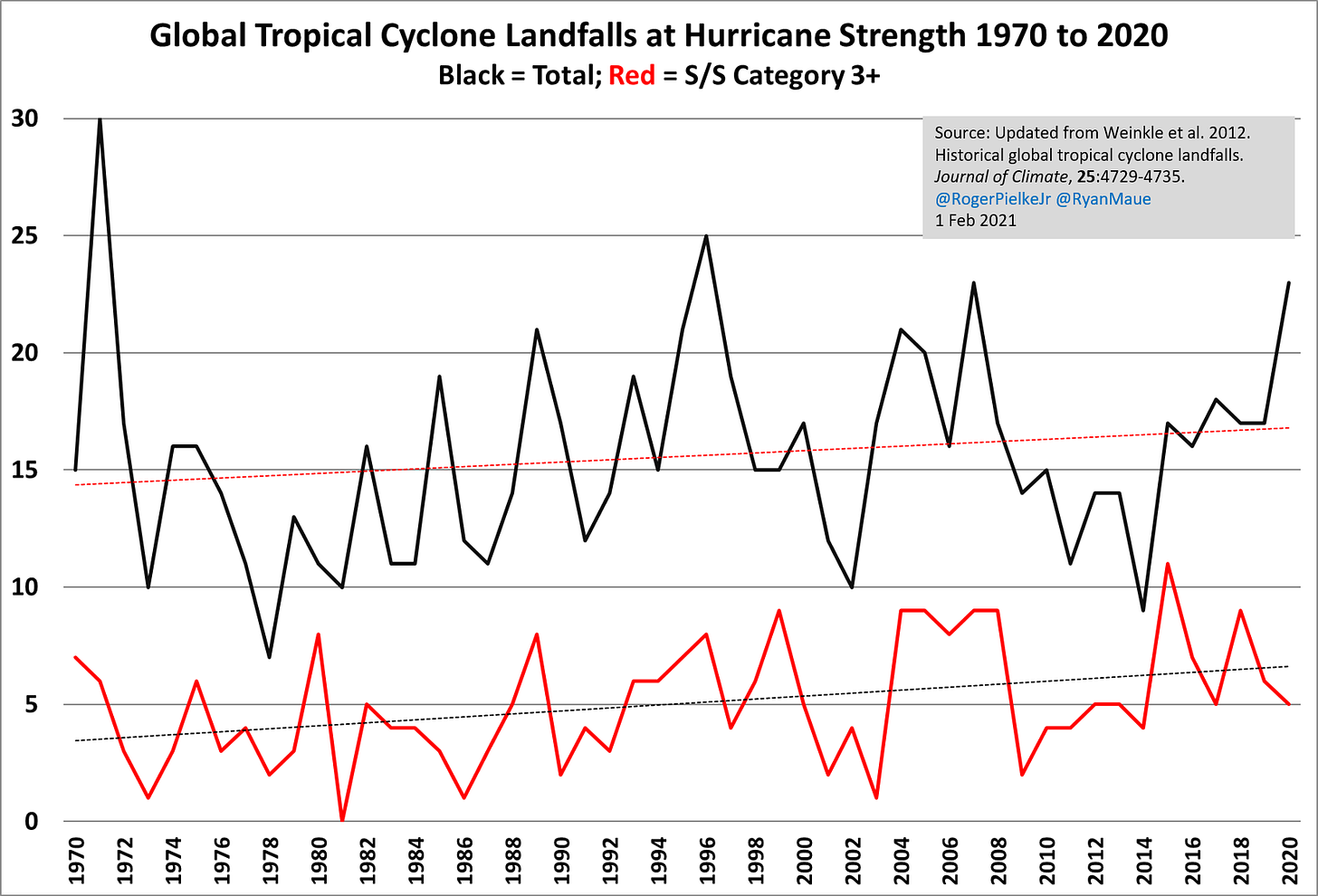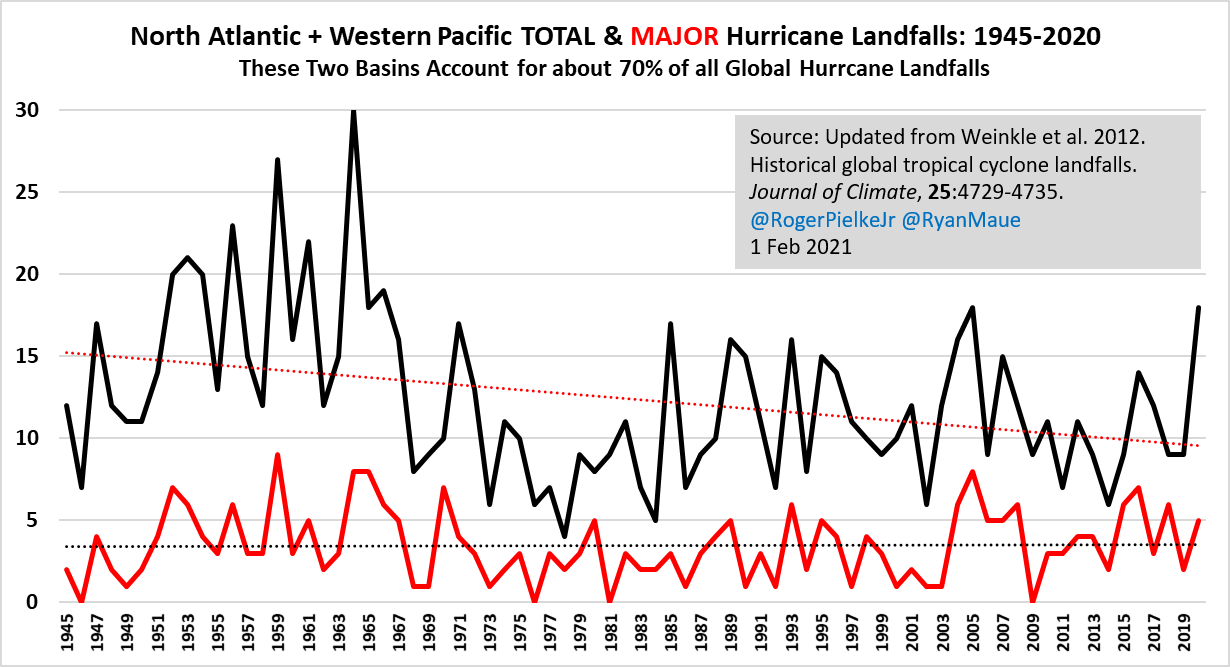A Remarkable Decline in Landfalling Hurricanes
@RogerPielkeJr https://t.co/AJrhYkDYec— The Honest Broker (@RogerPielkeJr) February 1, 2021
By Roger Pielke Jr.
Last week a paper published in Science concluded that worldwide, “To date, there has been no firm evidence of global trends of the frequency of tropical cyclones with maximum wind speed above the hurricane-force wind (64 knots) at landfall.” That finding, which confirms our work, was based on data since 1982. But what happens when we take a look further back in time? What we find might surprise you.
Since 2012, when we published the first comprehensive dataset of global landfalling hurricanes, we have updated the dataset annually (props to @RyanMaue for the heavy lifting).
Overall, 2020 was not an usually busy year on planet Earth for hurricanes. The figure below (via @RyanMaue) shows that 2020 had 44 total hurricanes, of which 21 reached major storm strength (technically, Category 3 or greater on the Saffir/Simpson Scale). According to Phil Klotzbach at Colorado State University, since 1980 the most hurricanes observed globally in one calendar year was 59 in 1992 (major = 38 in 2015) and the least was 38 in 2009 (major = 15 in 1981).
One thing to notice about hurricanes is the large variability in their occurrence from year-to-year and decade-to-decade. Not only do hurricanes vary, but so too does the proportion that makes landfall. While storms at sea pose threats to shipping, it is of course those storms that make landfall that pose the greatest threats to life and property.
Indeed, historically, about 60% of all economic damage from disasters worldwide comes from landfalling hurricanes in the United States, and of that damage, more than 80% results from major hurricanes. It is thus no surprise that hurricanes capture interest and attention. Because of their fearsome destructive potential, it is also no surprise that hurricanes have become a central symbol in policy advocacy related to climate change.
For instance, just last week John Kerry, President Biden’s Special Envoy on Climate Change, explained that the economic damage associated with hurricanes could be reduced via climate policies: “There are countless economic analyses now that show that it is now cheaper to deal with the crisis of climate than it is to ignore it. We spent $265 billion, two years ago, on three — three storms: Irma, Harvey, and Maria.”
Our latest update of global hurricane landfalls can be seen below. It shows landfalls for the 51 years 1970 to 2020. With 23 total landfalls, 2020 saw the most hurricane strikes since 2007, and the third most since 1970. The large number of 2020 landfalls was in part to the very busy North Atlantic hurricane season, which saw 9 total landfalls. The North Atlantic averaged 2.5 landfalls per year 1970 to 2019.
While consistent global data is available for landfalls back to 1970, other basins have records that reliably go back further in time. The North Atlantic and Western Pacific basins together accounted for about 70% of global landfalls, and the combined record of landfalls goes back (at least) to 1945 in both basins. The figure below shows combined landfalls in these two basins from 1945 to 2020, spanning 76 years.
With a longer-term perspective, we see a very different pattern in landfalling hurricanes than we do starting an analysis in 1970. The 1970s and early 1980s have long been understood to represent a period with lower tropical cyclone activity than before or since. That means that any analysis of trends starting from this period will likely show upwards trends, but that such trends need to be interpreted very carefully.
That is why recent expert assessments of global tropical cyclone activity have expressed caution in asserting the presence of or causes for trends in a wide range of storm metrics, including overall frequency and intensity, poleward migration, propagation speed, regional occurrence, intensity distribution (across storms and within regions), storm tracks, precipitation, storm surge and landfall frequency (for details see Cha et al. 2020, Lee et al. 2020, Knutson et al. 2019).
With a longer-term view from the two ocean basins that see about 70% of all landfalls, we see that variability in landfalling hurricanes has been much larger than observed over the past 40 or 50 years. In fact, the overall number of landfalling hurricanes has decreased dramatically since the 1940s, while the number of major hurricane landfalls has shown no trend. This will likely be counter-intuitive to many.
Looking to the future, is it better to extrapolate trends from 1945, 1970, 1980 or some other year? Projection-based on curve-fitting is usually a mug’s game, and the same is true here. The simple fact is that if you tell me what trend you want in hurricanes, I can probably find it for you based on the selection of a starting point for analysis. It is a cherry-picker’s feast. That helps to explain why the Intergovernmental Panel on Climate Change has concluded that it is premature to assert the detection of trends in hurricanes resulting from human-caused climate change.
While the future is uncertain — for reasons of climate variability and human-caused climate influences — we do know with certainty how to save lives and protect property from the impacts of tropical cyclones. Even if the world returns to a much more active period of hurricane activity, like that observed in the 1950s, we can be confident that progress made in forecasting, warning, evacuation and overall societal resilience empowers us to be well-prepared for whatever the future may hold.
| 1 |






